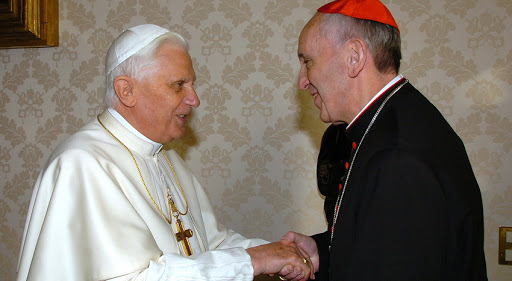The long papacy of Bl. John Paul II means that many of us have not lived with a variety of popes. Now, within eight years we have gotten used to three popes, and with the retirement of Pope Benedict, some Catholics are finding it difficult to accept Pope Francis.
It’s therefore helpful to remember that in the divine economy, the saints all have different parts to play according to their own charisms and personalities. St. Thérèse of Lisieux wrote, “How different are the variety of ways through which the Lord leads souls! Souls are as different as faces!” The variety of saints is like different flowers, trees and shrubs in a garden. Studying the saints helps us understand God’s wonderful ways of working in the world. Therefore, looking at St. Benedict and St. Francis of Assisi will help us see how Pope Benedict and Pope Francis complement one another.
St. Benedict was born into a society in chaos. At the end of the fifth century, the Roman Empire was crumbling, and it began to drift into decadence, despair and pessimism. The armies had been pulled back and the barbarians were invading. In the midst of the encroaching darkness, Benedict established little core communities of radical disciples. Men withdrew from the world with Benedict to live quiet lives of prayer, study and work. Those core communities became the seeds of what flowered into the great civilization we know as medieval Christendom.
As we understand Benedict the Saint, we will understand Benedict the Pope. Joseph Ratzinger has always been a reserved and scholarly person; when he was elected pope, he admitted that he had been looking forward to retiring to a little house to live with his brother in obscurity. When he took the name ‘Benedict’, Joseph Ratzinger was doing more than identifying with his predecessor, Benedict XV. He was also doing more than identifying with the great saint who is the patron of Europe and the founder of the Benedictine order.
The name Benedict signified an embracing of a monastic way of looking at the world. Despite being on the world stage as pope, Benedict XVI was always essentially a reserved, scholarly and retiring man. We should not be surprised that he made history by retiring from the papacy. With hindsight, we can see that it was on the cards from the beginning of his pontificate.
What gifts did Benedict XVI bring to the Petrine Office? He brought the Benedictine love of beauty and tradition in the liturgy; he contributed the Benedictine love of study, scholarship and teaching; he brought a quiet, studious and prayerful mood to the papacy; he brought reverence and respect and a depth of dignity to the celebration of Mass and the Church’s work in the world. Anyone who has visited a Benedictine monastery will notice this same mood reflected in the papacy of Benedict.
Like St. Benedict before him, St. Francis was also born into a Church in chaos. In the twelfth century, the Catholic Church was besieged by corruption from within and threatened with persecution from without. St. Francis came on the scene with his famous vow of poverty, a life of joyful simplicity and an outgoing personality. Francis also followed the religious life, but it was lived out not in a Benedictine monastery, but in the burgeoning cities and in wandering through the world.
As we saw St. Benedict alive in Pope Benedict; likewise, we are already seeing, (and can expect to see more of) St. Francis alive in Pope Francis. The two are not contradictory, but complementary, and the way to see how they work together is to see the big picture of the different gifts these two saints bring to the Church, and therefore the different gifts each pope will bring.
As a friar, Francis represents the active religious life. As a monk, Benedict represents the enclosed life of prayer. They’re like the two sisters of Bethany: Francis is the busy Martha, and Benedict, the contemplative Mary. If the Church is going to function as she ought, she needs both. The Body of Christ needs both.
How amazingly providential, then, that we now have two popes: Pope Francis and Pope Emeritus Benedict! Pope Benedict following the Benedictine way by retiring to a life of prayer, study and work, while Pope Francis steps on to the world stage to live the life of activity, reform and renewal. The two popes are meeting today, and I am convinced that when Pope Benedict moves to his hermitage in the Vatican, the two of them will meet on a regular basis to support one another as brothers in arms.
Finally, there is a lesson for the whole Church in the two popes: we all need to run on the path of God’s commandments on these two legs: the contemplative and the active. We desperately need more time in prayer, more time in contemplation, more time with God. Then we also desperately need to get up off our knees and move forward to not only “talk the talk” but to “walk the walk” in the great adventure of following Christ the Lord.
Fr Dwight Longeneckeris the author of St Benedict and St Therese–the Little Rule and the Little Way. Visit his blog, browse his books and be in touch at dwightlongenecker.com.

